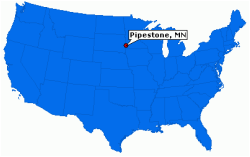History of Pipestone National Monument
|
"An Indian-oriented park": Native Americans and the monument
The establishment of the monument in 1937 gave the Park Service a set of specific responsibilities at Pipestone. Among the most important of these was the obligation to preserve the right of Native Americans to quarry in a traditional manner. The rights granted in the proclamation were both new and old. They had historic standing since the Treaty of 1858, which guaranteed the Yankton Sioux the right to quarry pipestone on the reserved area. The court case that began in the 1890s was based on those rights, but its resolution in 1928 extinguished all legal Native American claims to the quarries and their use. Between 1928 and 1937, Native American people had no more legal right to use the quarry than anyone else. Nonetheless, after 1928, Indian School administration officials allowed Native Americans from any tribe to quarry, a reality that the enabling legislation for the monument codified. |
The monument proclamation established a permanent legal relationship between the Park Service and native peoples. This relationship, with its many complications, has been crucial to NPS management of the area.
From its inception, Pipestone National Monument has been, in the words of former Superintendent Lyle K. Linch, an "Indian-oriented park." [1] Native Americans and their myriad cultures are essential to the monument. The quarries the Park Service seeks to preserve have significance because of their importance to Native Americans; the interpretation is meaningful because of the presence of Native Americans working the stone in time-honored fashion. That orientation has made the management of the monument unique among national park areas in the United States. Click here to read the whole story |


